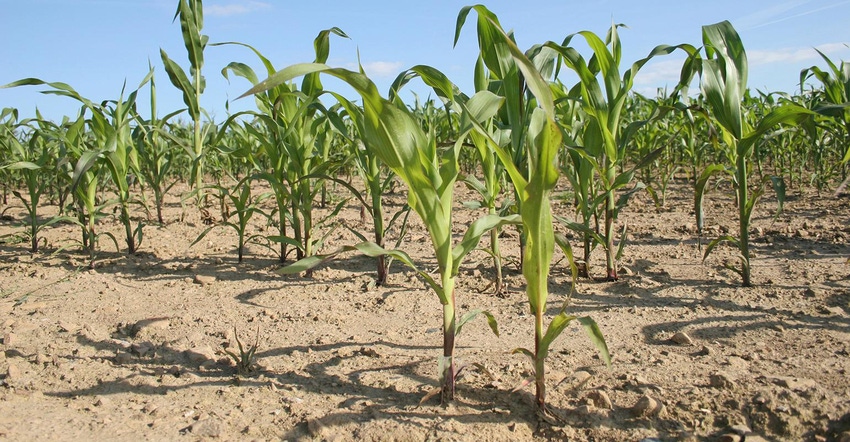May 22, 2018

Each year in the spring, as corn is emerging, my colleagues and I get called out to assess why some fields are exhibiting uneven corn stands. There are many reasons why a couple of corn plants could be missing here and there in your corn rows. Here are five common causes for you to keep in mind.
1) Variability in soil moisture. A corn seed will imbibe roughly 30% of its weight in water during the germination process. Soil moisture in the seed zone can vary within the field due to differences in topography and soil type. Generally, soils are not uniform and spatial soil texture variability can be noticed across fields.
A key factor for the soil’s water-holding capacity is soil texture. Soils that are course-textured have a lower moisture-holding capacity due to high porosity and the ability to drain excess water quicker than fine-textured soils. Because fine-textured soils have varying percentages of silt and clay as the main components, they have a higher moisture-holding capacity. Changes in soil texture across a field affect moisture availability, which in turn affects the crop stand.
Planting depth can also influence germination and uniform emergence. Planting at uneven seed depths or too shallow can result in uneven moisture in the seed zone. If corn is planted less than 1.5 inches, uneven germination and emergence is greatly increased due to drying of surface soils. Standard corn seeding depth recommendations for Iowa are 1.5 to 2 inches, in which the moisture level is at field capacity. This seeding depth allows for quick emergence and maximum emergence rates, as well as proper root system development. However, in dry planting conditions, planting depth may have to be increased to plant into adequate moisture.
Primary tillage practices ahead of the planter can also attribute to rapidly decreasing soil moisture compared to no-till fields. For this reason, in dry situations, no-till fields may have more even emergence and early growth compared to fields tilled in a dry spring.
2) Soil temperature at planting. It takes approximately 90 to 120 growing degree days from date of planting for corn plants to emerge. According to data from ISU Extension climatologist Elwynn Taylor, if soil temperature is averaging 50 to 55 degrees F at time of planting, corn may take up to three weeks to emerge. Temperatures averaging 60 degrees, may have emergence in 10 to 12 days. Soil temperatures near 50 degrees is the optimum temperature at which we want to start planting corn.
Soil temperatures affect growth of both the radicle (first root) and coleoptile (shoot). With soil temperatures below 50 degrees, seeds readily absorb moisture, as mentioned earlier, but do not initiate root or shoot growth. This opens up opportunities for insects and pathogens to attack seeds, resulting in poor emergence, especially if poor seedbed conditions are prolonged. Also, keep an eye on the extended forecast, as a significant change in soil temperature can cause a dramatic negative influence on the corn stand.
Research has shown that a swing of soil temperatures of 27 degrees (soil high and low temperature) will affect mesocotyl growth. Seed placed into the ground, not yet emerged, can be injured from a cold period, resulting in erratic and uneven stands. So, as a rule of thumb, regarding soil temperature, corn planting should begin when soil temperatures are close to 50 degrees and rising in conjunction with the forecast for warm weather over the next five to 10 days.
3) Seed-to-soil contact. For corn seed to imbibe the required moisture needed for germination, it��’s imperative to have good seed-to-soil contact in which soil is firmed around the seed. Working a field when it’s too wet can create cloddy seedbeds, resulting in uneven contact between seed and soil, allowing some seeds to absorb enough moisture to germinate while others are too dry.
Planting into soil conditions that are too wet can also contribute to poor seed-soil contact during planter operation. For one, the coulters of the planter are unable to optimally cut through the residue, resulting in seed contact with the residue in the seed furrow instead of soil.
Second, sidewall compaction is created due to disk openers smearing through the wet soil, creating a compacted soil that surrounds the seed, as well as the inability to properly close the seed furrow (leading to poor seed-to-soil contact). The compacted area restricts proper nodal root development as roots are unable to penetrate. This inhibits nutrient and water uptake to the seedling, affecting optimum germination.
4) Planter calibration and settings. As you’re looking at your fields and assessing the stand, you may notice doubles, skips or blanks in the row. Have you had your planter’s seed meters calibrated lately? Was the downforce set correctly on the planter?
Too much downforce can cause compaction problems when planting in wet soil conditions, and not having enough downforce in dry conditions can cause poor seed-to-soil contact. Both contribute to uneven emergence. Row cleaners that are properly set allow for removal of surface residue in the seed row, resulting in warmer soil temperatures and quicker uniform emergence.
5) Early-season pests. Insects can pose a threat to young corn seedlings and impact the final stand. Wireworms and white grubs most commonly feed on the seedlings belowground. Wireworms typically bore into the seed before or during germination, and hollow it out, while white grubs feed on fine root hairs, which can lead to root pruning with high enough populations. Both pests are problematic in fields that were previously in the Conservation Reserve Program, sod or pasture.
Other early-season pests to look for are black cutworm and true armyworm. Both are migratory and arrive in Iowa from the south by prevailing winds and spring storms. Black cutworms favor cool, wet soil conditions and feed on the foliage of the corn seedlings aboveground.
As we’ve had a relatively cool and wet spring here in Iowa in 2018, cornfields should be scouted based from the “peak flight” and moth capture results that will be shared on the ISU Integrated Crop Management website.
True armyworms also feed aboveground on foliage of corn plants. Adult true armyworm moths are attracted to fields that have living ground cover, which includes fields with grassy weeds or cover crops such as rye or grass. Fields that are minimum till, no-till or have a cover crop should be scouted for true armyworms in May and June. Upon arrival, the female moth will lay eggs on the living ground cover, and larvae will then feed on the corn plants as a food resource.
In summing up, it’s important to scout and monitor each field at least once a week early in the season, as there are many considerations, agronomic factors, management strategies and decisions that can influence potential yield of the corn crop. For insects, you may need to scout twice a week as you assess feeding injury and thresholds.
To help with identification of pests and management decisions, ISU Extension provides a variety of agronomic publications and field guides that can be obtained from the ISU Extension store. Another source for information is the ISU Extension ICM website previously mentioned in this article.
Basol is an ISU Extension field agronomist located at Nashua in northeast Iowa. Contact him at [email protected].
About the Author(s)
You May Also Like






